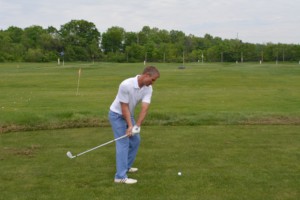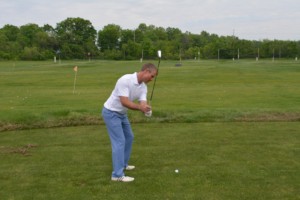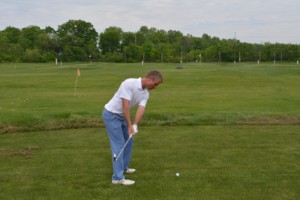A straight takeaway can eliminate wayward shots
Bad shots can start with a takeaway that is too far inside or too far outside. While it may be easy to define the most ideal impact position, it is not so easy to pinpoint the most ideal takeaway. After all, no one I’ve ever known has hit the ball during the backswing. John Daly can come close. Some have hit it during their practice swing. But by and large, the part that matters most is how you return the club to the ball.
Having said that, taking the club back on the most direct path can lend itself nicely to finding a friendly route back to the ball. It can lead to a swing that is not so largely dependent on timing. In short, it can make things easier. The most telling “position” during the takeaway is probably the position of the club at the halfway point. The two most common flaws are taking it too far inside and lifting it too far outside. The good news is both are easily identified and they’re just as easy to fix.
Too far inside
One of the things that is difficult for the better athlete to get a feel for is the need for passive hands during the takeaway. Most sports rely on active hands, and because of this control there is a temptation to control the club with hand action right from the start. The result of this is a very exaggerated move to the inside. There isn’t anything more disruptive to a proper takeaway. There are two dangers associated with this move to the inside.
First, it “steals” the club from its proper swing plane, that is, the route the club should travel to most easily deliver power and accuracy to any golf shot.
Second, getting the club so far to the inside brings on the possibility of hitting any one of three shots:
- The high “wounded bird” to the right.
- The perfectly timed straight shot down the middle.
- And, of course, the duck-hook to the left, a product of swinging drastically from the inside while also shutting down the face at impact. Many people have described this as a feeling of “being stuck” prior to contacting the ball.
Too far outside
Most golfers who take the club too far outside at takeaway are doing so to either remedy the thought that they might be taking it too far inside or they are simply standing too close to the ball at address. The good news is that, provided you make a full shoulder turn, taking the club too far to the outside is not nearly as costly as the “yank” to the inside. It may feel weaker, but the truth is that you’ll normally hit the ball somewhere between straight and straight right.
In other words, you will have eliminated the trouble on the left side of the fairway.
Ideal
In order to swing on plane, and therefore require the fewest compensatory moves during your swing, you should feel like you’re taking it neither inside nor outside. In fact, as your shaft become parallel to the ground, the shaft should also be parallel left of your target line. For most, reaching this halfway point will allow everything that come afterward to fall perfectly into place.
This brings us to the topic of the club face. Where should it be positioned?
At the halfway point, the club face should nearly parallel your spine. This means the face should be facing neither straight out or straight down. Instead, it should be angled to match the tilt of your spine, which will vary depending on what club you are swinging.
If you’re having a tough time achieving a consistent and powerful impact there is a good chance that a faulty backswing has made your swing a product of perfect timing. If this is the case, I would encourage you to examine your “halfway back position” to see how “on plane” is your takeaway. For many, it is the key that unlocks the correct path back to the ball.


